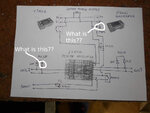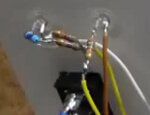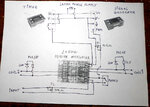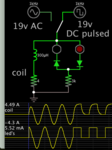drhiii
Newbie level 5

I have a very amateur level of competence when it comes to electronics, circuits, etc. Am looking at a Youtube project that combines a PEMF device (Pulsed Electromagnetic Field Therapy) and a RIFE device (Royal Rife, Tesla, etc).. dual circuitry. There are two or three elements in the hand drawn schematic that I do not understand and was hoping someone could put eyes on it and identify those pieces. I have sourced almost all of the parts, but a parts list would really have helped. I’ve tried to ask the originator of this schema but have yet to receive any replies. The engineer who drew this up posted barebones schema and vid, and I can almost get through it. Almost. So looking to this learned group for any help to interpret this schema and video.
Am attaching an image with 2 balloons w/text and pointers asking “what is this?”, etc. Plus an additional question is… on the front panel there appear to be two, or three different kinds of lights. Are they all the same(for pulse, pulse, out, out and power), as in LEDs?, Or might they different kind of lights for the three different types/labels. Cannot discern from the schema and vid.
Am also attaching some images that snapshot the project, taken from the video.
Any advice would be most helpful. At the least
Fwiw, the end game of this is the PEMF aspect assist my wife who lives in chronic pain (6 total joint replacements for instance). Additionally, she is a liver transplant recipient.. so lots going on here. The magnetic pulse fields do provide a measure of relief. Hence why am pursuing this.
Youtube link: https://www.youtube.com/watch?v=-KJtAUd_Yec&t=5s
Schematic: https://snag.gy/ZGwE8N.jpg



Am attaching an image with 2 balloons w/text and pointers asking “what is this?”, etc. Plus an additional question is… on the front panel there appear to be two, or three different kinds of lights. Are they all the same(for pulse, pulse, out, out and power), as in LEDs?, Or might they different kind of lights for the three different types/labels. Cannot discern from the schema and vid.
Am also attaching some images that snapshot the project, taken from the video.
Any advice would be most helpful. At the least
Fwiw, the end game of this is the PEMF aspect assist my wife who lives in chronic pain (6 total joint replacements for instance). Additionally, she is a liver transplant recipient.. so lots going on here. The magnetic pulse fields do provide a measure of relief. Hence why am pursuing this.
Youtube link: https://www.youtube.com/watch?v=-KJtAUd_Yec&t=5s
Schematic: https://snag.gy/ZGwE8N.jpg







